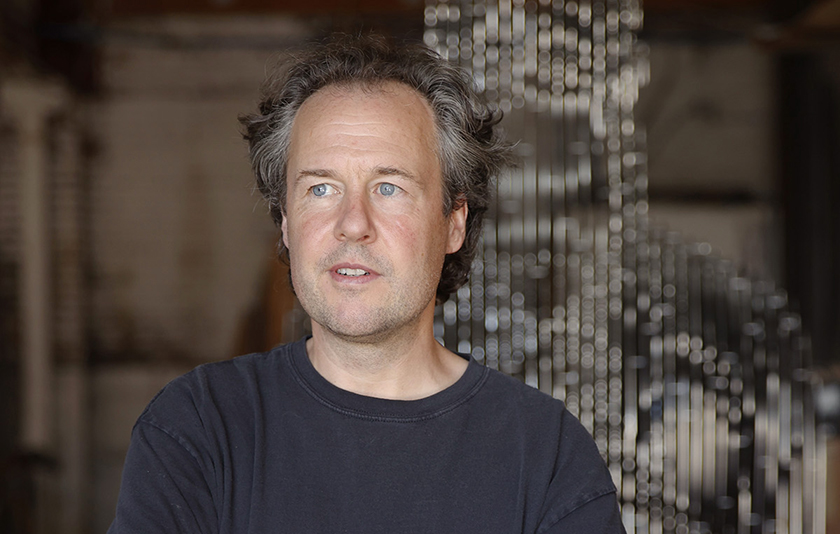
By the time Julian Voss-Andreae ’04 arrived in Portland, he was 29 years old, spoke some English — but not fluently — and would soon become a father.
He’d just immigrated from Germany. His background was steeped in physics, but as he sought to pursue his longtime interest in art, he didn’t fully fall in either discipline. He had no idea what he wanted to do.
But his first year design class at Pacific Northwest College of Art nudged him in the direction of the quantum sculptures that have since become his signature: large-scale, stainless steel human figures that can weigh thousands of pounds yet simultaneously disappear into thin air, works that have become public landmarks in 30 locations and enchant viewers everywhere from Taiwan to Azores and Minnesota to Miami.
Bridging the worlds of art, technology and science has broadened his reach. A scholar and writer as well, Voss-Andreae has captured the interest of dozens of art magazines, academic papers, and science and technology books throughout his career.
Even so, he said he only became truly sought after about three years ago. A Reddit post on his sculpture, “A Disappearing Act,” went viral and led to a 2018 Insider feature that drew millions of views.
“I was a complete outsider,” he said. “But I made my own niche and I was able to make a name for myself in unusual ways.”
Early and critical acclaim
Voss-Andreae didn’t fully appreciate the value of uniting his interests in science and art until his first 3D design assignment, when he saw another student chop up a 10-foot piece of lumber and form it into a small, tight ball.
It was an epiphany: Voss-Andreae was struck by its similarity to the behavior of protein chains as they twist into three-dimensional configurations, so he wrote a software program that could turn protein structural data into cutting instructions that would allow him to build sculptures of proteins.
“I like to work with my hands, and I was really intrigued,” he said. “With the technology available now, like 3D printing and scanning, I realized it was a new day for sculpture.”
Among his early works is a red alpha helix sculpture dedicated to Linus Pauling, the famed Portland chemist and two-time Nobel Prize winner. Realizing Pauling’s connection to Portland and his discovery of the spiral protein structure was so exciting to Voss-Andreae, he reached out to the owners of Pauling’s childhood home on Hawthorne Boulevard and proposed the sculpture.
“All I wanted to do is make this piece,” he said. “They paid for the materials, mostly the steel and the powder coating. I donated my labor. It was 10 feet tall and that became part of my thesis project.”
By the time Voss-Andreae graduated, his work had appeared in several locations in the Portland area, Washington state and even Art Basel in Miami. He began working full time in his garage-turned-studio, grinding out new sculptures for a growing number of exhibitions with a welder his wife bought for his birthday.
Eventually, his projects outgrew the space. One work, a three-stranded steel rope structure based on the collagen protein, was so tall he had to hook it on the top of a street pole to work on. Eight hours of welding and grinding every day drove his neighbors nuts, so he rented a cheap studio nearby, he said.
Achieving success — and a thick skin
Demand for Voss-Andreae’s work began to grow, but he had to push himself hard to keep reaching out. Shy and terrible at networking, he struggled with the marketing side of art — competition is so high, and it’s so hard to get your foot in the door, he said.
“You have to be so thick-skinned,” he said. “What I learned after a few years of heartbreak is that the only trick is to keep applying to new things. Be in the future — where do you want to go with art? You can’t look back on the opportunities you didn’t get. It will devastate you.”
His first major breakthrough happened in 2006. A sculpture of sliced stainless steel he created for a gallery in Sun Valley, Idaho, led to “Quantum Man,” an 8-foot-tall walking man composed of more than 100 vertical steel sheets, and similar works he continues to create today. Now he has some help — a team of seven employees grind, sand and shape the steel sheets for him in his 6,000-square-foot Sellwood studio while he manages the designs and paperwork.
Serious stress has dogged him throughout his career, from not feeling confident about his math skills to wondering if his sculpting abilities were strong enough, but he kept pushing and pushing, and he never compromised on his determination to work full time as an artist. At 51, he’s not sure what his next steps are. He’s developed interests “beyond sculpture and art, in what can be called spirituality,” he said.
Until then, the projects keep coming: a commission for a Moscow museum, two gallery sculptures and back orders that can finally move forward — along with interest in public works. Last year, when the world was locked down, he recorded his best financial year ever.
“It can be such a mixed bag,” he said. “I’m incredibly grateful.”
"artist" - Google News
June 28, 2022 at 08:10PM
https://ift.tt/6youlJY
'A new day for sculpture': Quantum artist reflects on career - willamette.edu
"artist" - Google News
https://ift.tt/utRMDae
Bagikan Berita Ini














0 Response to "'A new day for sculpture': Quantum artist reflects on career - willamette.edu"
Post a Comment